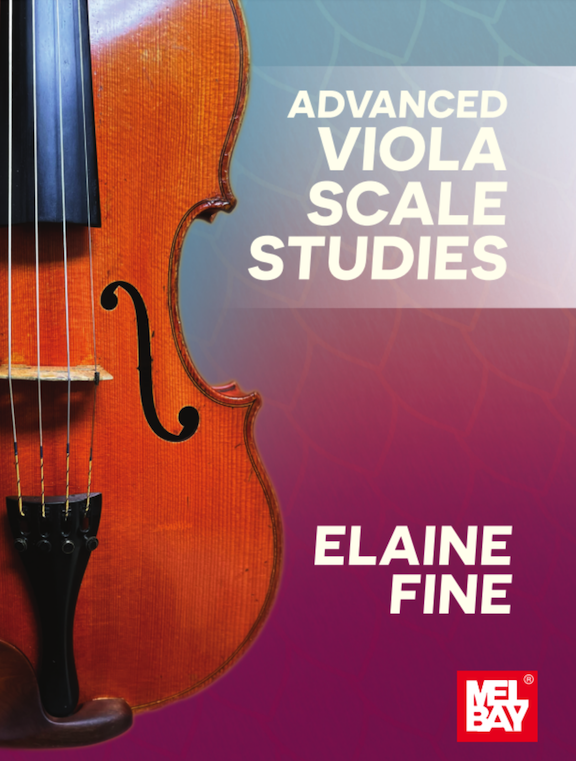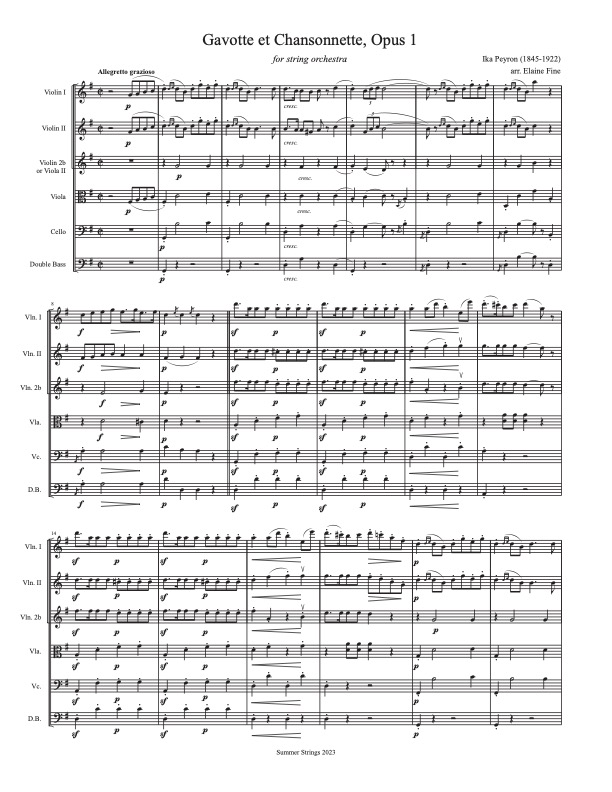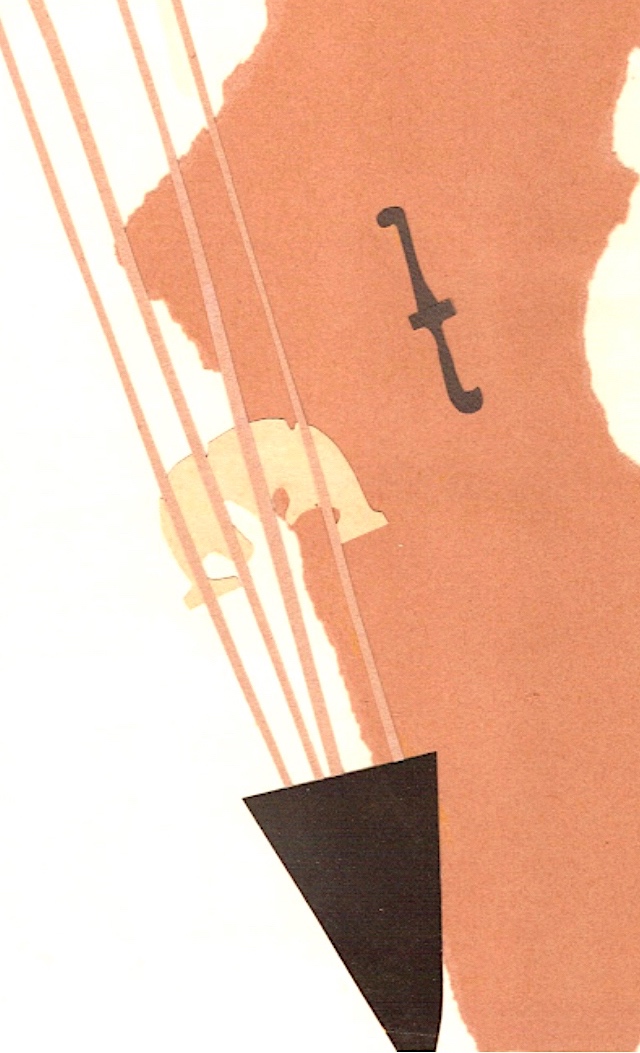Gish Gallop for piccolo and piano
[June 30, 2024]
You can listen to a computer-generated recording here. You can find the score and part on this page of the IMSLP.
You can listen to a computer-generated recording here. You can find the score and part on this page of the IMSLP.
Transcription: Marion Bauer's Elegie for Violin and Piano or Flute and Piano
PDF files for the score and parts for both versions are available on this page of the IMSLP. You can listen to the violin version here, and the flute version here.
Magicicada XIX for String Quartet
You can listen here and get the music here. You can also find it on this page of the IMSLP.
You will also be able to find a version for string quintet (quartet with bass, which can also be played as a string orchestra piece), and one for string orchestra with a violin 2b part and a repeat, making the tonal image of the emergence a little longer, in the transcriptions tab.
You will also be able to find a version for string quintet (quartet with bass, which can also be played as a string orchestra piece), and one for string orchestra with a violin 2b part and a repeat, making the tonal image of the emergence a little longer, in the transcriptions tab.
Arrangement: Für Elise for String Quartet
You can find the score and parts on this page of the IMSLP (transcription tab, of course).
You can listen to a computer-generated recording here.
You can listen to a computer-generated recording here.
Eleven Miniature Studies for Viola Solo
[March 24, 2024]
This is a viola adaptation of Eleven Miniature Studies for Violin Solo. You can find the music on this page of the IMSLP.
This is a viola adaptation of Eleven Miniature Studies for Violin Solo. You can find the music on this page of the IMSLP.
When it's time to move on
February 19, 2024
You can listen to a computer-generated file here, and find the music here. The music is also available on this page of the IMSLP.
I wrote this piece in memory of the pianist Eric Larsen (1952-2024), who was a dear friend and chamber music partner of my very dear friend Daniel Morganstern. The poem, written by Danny's mother Milly (1913-2000), is one that he shared with me only recently, and a poem that was at the very front of both his mind and my mind during Eric's last days.
We are single threads
intertwined
in the fabric
of each other’s lives
We are words
in each other’s stories
We are notes
in each other’s songs
When it’s time to move on
We step
over the edge
into a new space
where we are transformed
as color
in the thread
as meaning
in the word
as overtone
in the note
We continue
intertwined
through life, death
and transformation
On our journey
--Milly Morganstern
You can listen to a computer-generated file here, and find the music here. The music is also available on this page of the IMSLP.
I wrote this piece in memory of the pianist Eric Larsen (1952-2024), who was a dear friend and chamber music partner of my very dear friend Daniel Morganstern. The poem, written by Danny's mother Milly (1913-2000), is one that he shared with me only recently, and a poem that was at the very front of both his mind and my mind during Eric's last days.
We are single threads
intertwined
in the fabric
of each other’s lives
We are words
in each other’s stories
We are notes
in each other’s songs
When it’s time to move on
We step
over the edge
into a new space
where we are transformed
as color
in the thread
as meaning
in the word
as overtone
in the note
We continue
intertwined
through life, death
and transformation
On our journey
--Milly Morganstern
Four Songs from Sunset Gun
You can find the music as well as computer-generated audio file on this page of the IMSLP
Unbeschwerte Amore for two violas d'amore
[November 18, 2023]
You can find the score and parts for this piece (written for the Duo Aliquot) on this page of the IMSLP.
You can find the score and parts for this piece (written for the Duo Aliquot) on this page of the IMSLP.
Salomé's Dance for Violin, Viola, and Cello
You can hear this music accompanying some of the final scenes of the 1922/23 silent film (one hundred years ago!) of Salomé that was produced, directed, choreographed, acted, and danced by Alla Nazimova through this link. The score and parts on this page of the IMSLP.
The piece, which is ten minutes long, can be played with or without the film.
Advanced Viola Scale Studies
You can find the music on this page of the Mel Bay website.
Nathan Groot is in the process of recording them all. You can watch and listen here.
Nathan Groot is in the process of recording them all. You can watch and listen here.
Transcription: Lili Boulanger Nocturne and Cortege for Viola and Piano
Published by International Music Company and available through this link.
Salomé Dance Scene for clarinet, violin, cello, and piano
You can find the music on this on this page of the IMSLP, and you can watch the film clip from the 1918 Fatty Arbuckle and Buster Keaton film The Cook (with this music) here. You are welcome to use this film segment for a performance (you can set it on mute while you play).
The Forest Near Ingolstadt
[March 11, 2023]
The music and a computer-generated recording are available on this page of the IMSLP. You can also listen here.
The music and a computer-generated recording are available on this page of the IMSLP. You can also listen here.
Transcription: Massenet's Méditation from Thaïs for viola and piano
I think that the best known musical meditation is the one from Jules Massenet's 1894 Opera Thaïs. The action that accompanies this piece happens offstage, when Thäis leaves her life as a pleasure-seeking courtesan, and enters religious life. After the Méditation, the monk Athanaël, who had persuaded Thäis to convert, realizes that he is in love with her.
The Méditation is set for solo violin, two harps, winds, and a chorus of closed-mouth singers. For my transcription for viola and piano I transposed the piece into G major (a fifth lower), and rewrote the piano part to better reflect the colors, pitches, and motion of the original score.
Martin Pierre Marsik's piano reduction of the Méditation was published by Heugel in 1894, and I imagine it was approved by Massenet. But Marsik's piano reduction doesn't sound very good transposed a fifth lower, and a need for a setting of the piece for viola and piano wasn't on anybody's radar during Massenet's lifetime.
Just for a lark, after making my viola and piano edition, I made a personal copy transposed back into the original key, and when I played it on the violin with a pianist friend, it felt better to play with than the Marsik piano reduction. But I guess I am a bit biased.
My edition is now available from the International Music Company (and will be among the new issues on this page soon), and I am very grateful that they respected my choice to rewrite the piano part.
The Méditation is set for solo violin, two harps, winds, and a chorus of closed-mouth singers. For my transcription for viola and piano I transposed the piece into G major (a fifth lower), and rewrote the piano part to better reflect the colors, pitches, and motion of the original score.
Martin Pierre Marsik's piano reduction of the Méditation was published by Heugel in 1894, and I imagine it was approved by Massenet. But Marsik's piano reduction doesn't sound very good transposed a fifth lower, and a need for a setting of the piece for viola and piano wasn't on anybody's radar during Massenet's lifetime.
Just for a lark, after making my viola and piano edition, I made a personal copy transposed back into the original key, and when I played it on the violin with a pianist friend, it felt better to play with than the Marsik piano reduction. But I guess I am a bit biased.
My edition is now available from the International Music Company (and will be among the new issues on this page soon), and I am very grateful that they respected my choice to rewrite the piano part.
Transcription: Telemann Tafelmusik Sonata à 4 for String Orchestra
I have loved this piece since I first played it as a flutist nearly fifty years ago. I think that it is one of Telemann's best pieces, and I am very proud to share it as a string piece (a fifth lower than the two flute and recorder original). You can listen to a recording here.
And you can find the music on this page of the IMSLP.
And you can find the music on this page of the IMSLP.
Nocturne for String Quartet or Viola Quartet
[May 29, 2023]
[May 30, 2023]
You can listen to the string quartet version here, and the viola quartet version here. And you can find the score and parts for both versions on this page of the IMSLP.
You can listen to the string quartet version here, and the viola quartet version here. And you can find the score and parts for both versions on this page of the IMSLP.
Will you dance for me Vashti?
The music and a computer-generated audio file is available on this page of the IMSLP.
Made in Hungary
Marjorie Hanft and I collaborated on this poetry-with-interludes project in 1996. I recently found the music, and made an updated and revised score.
The music is available on this page of the IMSLP.I wrote this as a set of interludes to be played between poems, but was pleased to find that it also works quite well to read the poetry yourself while listening to the music.
Two Little Night Pieces for Three Violas d'amore
[May 7, 2023]
I. The Moon is a Cracked Dinner Plate
II. Toys in the Attic
You can listen to it here, and find the music on this page of the IMSLP.
I. The Moon is a Cracked Dinner Plate
II. Toys in the Attic
You can listen to it here, and find the music on this page of the IMSLP.
Transcription: Mozart Piano Sonata K545 for String Quintet or String Orchestra
[Transposed into D major]
You can find the music on this page of the IMSLP (via the transcription tab).
You can find the music on this page of the IMSLP (via the transcription tab).
The Year, a New Year's Greeting for 2023
You can find the music for medium voice here (there's also a version for high voice). You can listen to the medium voice version here, and you can find the music for both on this page of the IMSLP.
Film Noir for Piano Trio
[December 3, 2022]
You can find the score and parts on this page of the IMSLP. You can listen to a computer-generated recording here.
You can find the score and parts on this page of the IMSLP. You can listen to a computer-generated recording here.
Arrangement: Sinfonia after the Bach Flute Sonata BWV 1033
You can find the score and parts for this arrangement on this page of the IMSLP.
You can listen to a computer-generated recording here.
You can listen to a computer-generated recording here.
Arrangement: Ika Peyron Gavotte et Chansonette, Opus 1
The Swedish composer Ika (Fredrika) Peyron (1845-1922) began her musical life as a pianist. In 1865 she married a merchant who became a Member of Parliament, and lived in Stockholm with him and their three sons. She studied piano, harmony, and counterpoint, and wanted to compose, but found little encouragement because she was a woman. During the 1870s attitudes towards music written by women had changed (as evidenced by the carer of Amanda Maier), and Ika Peyron devoted her time to writing and performing her music in the Stockholm salons.
She wrote songs, music for violin, and mostly music for piano. Altogether we know of forty pieces.
This charming Gavotte et Chansonette, her Opus 1, works very nicely for strings. A PDF of this arrangement (as well as the piano original) is available on this page of the IMSLP. You can also find the music here.
You can listen to a computer-generated recording here.
She wrote songs, music for violin, and mostly music for piano. Altogether we know of forty pieces.
This charming Gavotte et Chansonette, her Opus 1, works very nicely for strings. A PDF of this arrangement (as well as the piano original) is available on this page of the IMSLP. You can also find the music here.
You can listen to a computer-generated recording here.
Subscribe to:
Posts (Atom)



















































